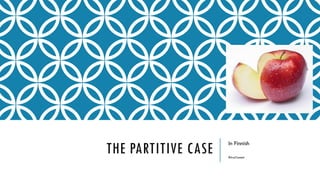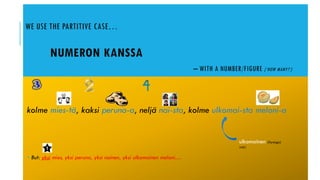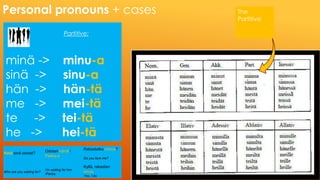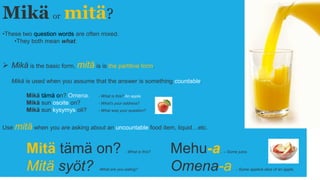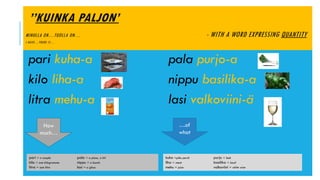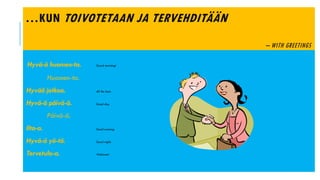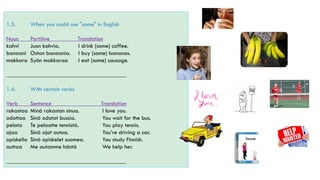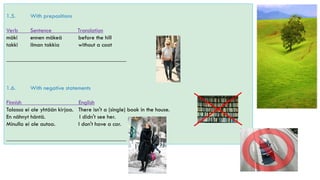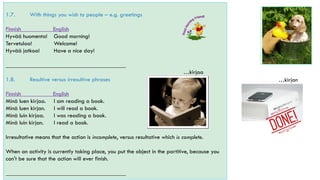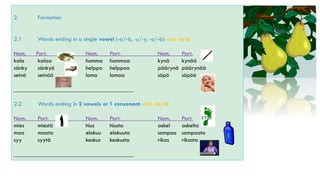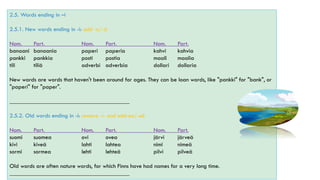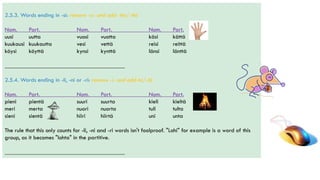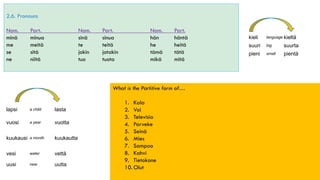The partitive case partit
- 1. THE PARTITIVE CASE In Finnish RitvaTammi
- 2. WE USE THE PARTITIVE CASE… NUMERON KANSSA – WITH A NUMBER/FIGURE (’HOW MANY?’) kolme mies-tä, kaksi peruna-a, neljä nai-sta, kolme ulkomai-sta meloni-a  But: yksi mies, yksi peruna, yksi nainen, yksi ulkomainen meloni… ulkomainen (foreign) (adj.)
- 3. Partitive object ’MIKÄ…?’ – ’MITÄ…?’ ’WHAT…’ MIKÄ TÄMÄ ON? MITÄ TÄMÄ ON? (concrete countables) (uncountables, abstract) ---------------------------------------------------------------------------------------------- MIKÄ tämä on? MITÄ lasissa on? What is this? What is there in the glass? Se on lasi. Lasissa on vettä. PARTITIVE It is a glass. There is water in the glass. MIKÄ tämä on? MITÄ kupissa on? Se on kuppi. Kupissa on kahvia. PARTITIVE Juon vettä. Juon kahvia. MILLAINEN lasi on? MILLAISTA vesi on? Lasi on puhdas. Vesi on puhdasta. PARTITIVE MILLAINEN pullo on? Pullo on kylmä. MITÄ pullossa on? Pullossa on olutta. PARTITIVE WHAT is the glass LIKE? WHAT is the water LIKE? The glass is clean. The water is clean. WHAT is the bottle LIKE? The bottle is cold. WHAT’s in the bottle? There is beer in the bottle. puhdas = clean kylmä = cold vesi = water lasi = a glass pullo = a bottle olut = beer lasi vesi -> vettä kuppi kahvi -> kahvia
- 4. Personal pronouns + cases The Partitive Partitive: minä -> minu-a sinä -> sinu-a hän -> hän-tä me -> mei-tä te -> tei-tä he -> hei-tä Ketä sinä odotat? Who are you waiting for? Odotan häntä/ Pekka-a. I’m waiting for him /Pekka. Rakastatko minua? Do you love me? Kyllä, rakastan sinua. Yes, I do.
- 5. Mikä or mitä? •These two question words are often mixed. •They both mean what.  Mikä is the basic form, mitä is is the partitive form. Mikä is used when you assume that the answer is something countable. Mikä tämä on? Omena. - What is this? An apple. Mikä sun osoite on? - What's your address? Mikä sun kysymys oli? - What was your question? Use mitä when you are asking about an uncountable food item, liquid…etc. Mitä tämä on? - What is this? Mehu-a. – Some juice. Mitä syöt? -What are you eating? Omena-a. - Some apple/a slice of an apple.
- 6. ’’KUINKA PALJON’ MINULLA ON…TUOLLA ON… - WITH A WORD EXPRESSING QUANTITY I HAVE…THERE IS… pari kuha-a pala purjo-a kilo liha-a nippu basilika-a litra mehu-a lasi valkoviini-ä kuha =pike perch purjo = leek liha = meat basilika = basil mehu = juice valkoviini = white wine pari = a couple pala = a piece, a bit kilo = one kilogramme nippu = a bunch litra = one litre lasi = a glass …of what How much…
- 7. ’JUODA’/’SYÖDÄ’/’OSTAA’ + PARTITIIVI -’DRINK’/’EAT’ /’BUY’+ PARTITIVE (USUALLY) Juon vet-tä, valkoviini-ä, kahvi-a, tee-tä, olut-ta. Syön kala-a, kakku-a, liha-a, jäätelö-ä, leipä-ä, voi-ta. Ostan salaatti-a, tomaatti-a, kurkku-a ja kana-a. vesi = water valkoviini = white wine kahvi = coffee tee = tea olut = beer kala = fish kakku = cake liha = meat jäätelö = ice-cream leipä = bread voi = butter salaatti = lettuce tomaatti = tomato cucumber = kurkku kana = chicken
- 8. …KUN ET TIEDÄ TARKKAA MÄÄRÄÄ – EXPRESSING ’A LITTLE’, ’A FEW’ ,’SOME’ Saanko suola-a? - Can I have (some) salt? Lasissa on mehu-a. - In the glass, there is (some) juice. Lattialla on roski-a. – On the floor, there is (some) rubbish. Me ostamme tarvikkei-ta. – We(’ll) buy (some) appliances. suola roskat mehu tarvikkeet suola mehu roskat (plural) tarvikkeet (plural)
- 9. …KUN LAUSE ON NEGATIIVINEN – IN NEGATIVE STATEMENTS Hänellä ei ole auto-a. She has no car. Asunnossamme ei ole iso-a parveke-tta. In our apartment, there is no big balcony. Sinä et syö pasta-a. You don’t eat pasta. Me emme osta mehu-a. We don’t buy (any) juice. auto = a car parveke = a balcony pasta = pasta mehu = juice Positive: …on auto, on iso parveke …syöt pastaa, ostamme mehua (’some’)
- 10. …KUN TOIVOTETAAN JA TERVEHDITÄÄN – WITH GREETINGS Hyvä-ä huomen-ta. Good morning! Huomen-ta. Hyvää jatkoa. All the best. Hyvä-ä päivä-ä. Good day. Päivä-ä. Ilta-a. Good evening. Hyvä-ä yö-tä. Good night. Tervetulo-a. Welcome!
- 11. 1. Use 1.1. After numbers (not after yksi!) Noun Partitive Translation kuppi kaksi kuppia two cups olut kolme olutta three beers nainen neljä naista four women ________________________________________ 1.2. After words that express measurement Noun Partitive Translation kahvi kuppi kahvia a cup of coffee banaani monta banaania many bananas kilo puoli kiloa half a kilo ________________________________________
- 12. 1.3. When you could use "some" in English Noun Partitive Translation kahvi Juon kahvia. I drink (some) coffee. banaani Ostan banaania. I buy (some) bananas. makkara Syön makkaraa I eat (some) sausage. ________________________________________ 1.4. With certain verbs Verb Sentence Translation rakastaa Minä rakastan sinua. I love you. odottaa Sinä odotat bussia. You wait for the bus. pelata Te pelaatte tennistä. You play tennis. ajaa Sinä ajat autoa. You’re driving a car. opiskella Sinä opiskelet suomea. You study Finnish. auttaa Me autamme häntä We help her. ________________________________________
- 13. 1.5. With prepositions Verb Sentence Translation mäki ennen mäkeä before the hill takki ilman takkia without a coat ________________________________________ 1.6. With negative statements Finnish English Talossa ei ole yhtään kirjaa. There isn't a (single) book in the house. En nähnyt häntä. I didn't see her. Minulla ei ole autoa. I don't have a car. ________________________________________
- 14. 1.7. With things you wish to people – e.g. greetings Finnish English Hyvää huomenta! Good morning! Tervetuloa! Welcome! Hyvää jatkoa! Have a nice day! ________________________________________ 1.8. Resultive versus irresultive phrases Finnish English Minä luen kirjaa. I am reading a book. Minä luen kirjan. I will read a book. Minä luin kirjaa. I was reading a book. Minä luin kirjan. I read a book. Irresultative means that the action is incomplete, versus resultative which is complete. When an activity is currently taking place, you put the object in the partitive, because you can't be sure that the action will ever finish. ________________________________________ …kirjaa …kirjan
- 15. 2. Formation 2.1 Words ending in a single vowel (-a/-ä, -u/-y, -o/-ö): add -a/-ä Nom. Part. Nom. Part. Nom. Part. kala kalaa homma hommaa kynä kynää sänky sänkyä helppo helppoa päärynä päärynää seinä seinää loma lomaa söpö söpöä ________________________________________ 2.2 Words ending in 2 vowels or 1 consonant: add -ta/-tä Nom. Part. Nom. Part. Nom. Part. mies miestä hius hiusta askel askelta maa maata elokuu elokuuta sampoo sampoota syy syytä keskus keskusta rikas rikasta ________________________________________
- 16. 2.3. Words ending in -e: add -tta/-ttä Nom. Part. Nom. Part. Nom. Part. huone huonetta perhe perhettä kappale kappaletta kirje kirjettä lentokone lentokonetta taide taidetta parveke parveketta koe koetta aste astetta This doesn't count for names: (Ville -> Villeä) nor for "kolme" (kolmea), "itse" (itseä), "nalle" (nallea) and "nukke" (nukkea). ________________________________________ 2.4. Words ending in -nen: remove the -nen and add -sta/-stä Nom. Part. Nom. Part. Nom. Part. nainen naista hevonen hevosta suomalainen suomalaista eteinen eteistä iloinen iloista ihminen ihmistä sininen sinistä toinen toista tavallinen tavallista ________________________________________
- 17. 2.5. Words ending in –i 2.5.1. New words ending in -i: add -a/-ä Nom. Part. Nom. Part. Nom. Part. banaani banaania paperi paperia kahvi kahvia pankki pankkia posti postia maali maalia tili tiliä adverbi adverbia dollari dollaria New words are words that haven't been around for ages. They can be loan words, like "pankki" for "bank", or "paperi" for "paper". ________________________________________ 2.5.2. Old words ending in -i: remove -i- and add-ea/-eä Nom. Part. Nom. Part. Nom. Part. suomi suomea ovi ovea järvi järveä kivi kiveä lahti lahtea nimi nimeä sormi sormea lehti lehteä pilvi pilveä Old words are often nature words, for which Finns have had names for a very long time. ________________________________________
- 18. 2.5.3. Words ending in -si: remove -si- and add -tta/-ttä Nom. Part. Nom. Part. Nom. Part. uusi uutta vuosi vuotta käsi kättä kuukausi kuukautta vesi vettä reisi reittä köysi köyttä kynsi kynttä länsi länttä ________________________________________ 2.5.4. Words ending in -li, -ni or -ri: remove -i- and add-ta/-tä Nom. Part. Nom. Part. Nom. Part. pieni pientä suuri suurta kieli kieltä meri merta nuori nuorta tuli tulta sieni sientä hiiri hiirtä uni unta The rule that this only counts for -li, -ni and -ri words isn't foolproof. "Lohi" for example is a word of this group, as it becomes "lohta" in the partitive. ________________________________________
- 19. 2.6. Pronouns Nom. Part. Nom. Part. Nom. Part. minä minua sinä sinua hän häntä me meitä te teitä he heitä se sitä jokin jotakin tämä tätä ne niitä tuo tuota mikä mitä What is the Partitive form of… 1. Kala 2. Voi 3. Televisio 4. Parveke 5. Seinä 6. Mies 7. Sampoo 8. Kahvi 9. Tietokone 10. Olut lapsi a child lasta vuosi a year vuotta kuukausi a month kuukautta vesi water vettä uusi new uutta kieli language kieltä suuri big suurta pieni small pientä

